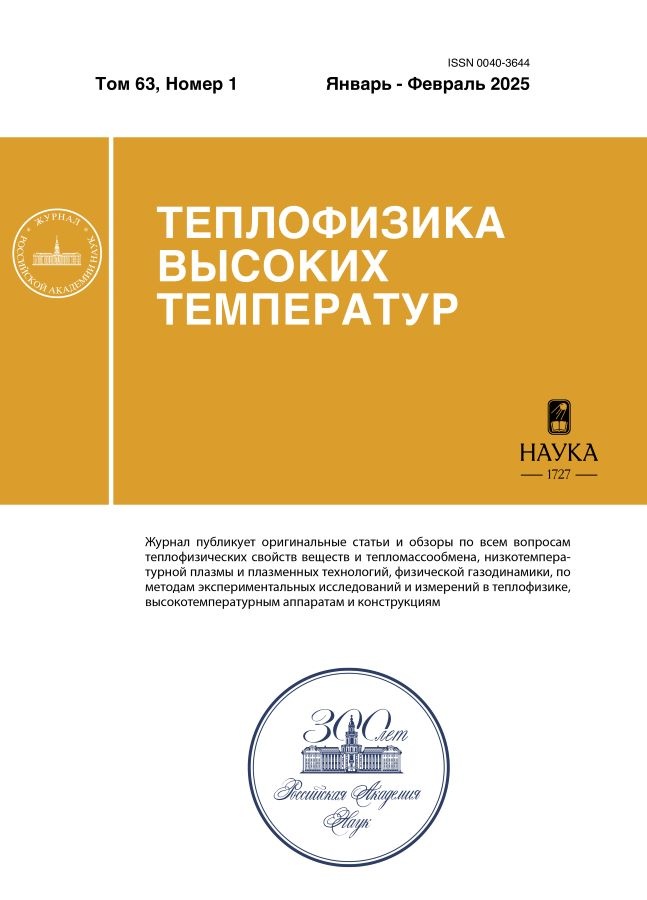Экспериментальное и численное исследование управления возмущениями на границе поперечной струи в сверхзвуковом потоке с помощью искрового разряда
- Autores: Волков Л.С.1, Селивонин И.В.1, Фирсов А.А.1
-
Afiliações:
- Объединенный институт высоких температур РАН
- Edição: Volume 63, Nº 1 (2025)
- Páginas: 24-31
- Seção: Plasma Investigations
- URL: https://ter-arkhiv.ru/0040-3644/article/view/689133
- DOI: https://doi.org/10.31857/S0040364425010045
- ID: 689133
Citar
Texto integral
Resumo
Работа посвящена исследованию влияния периодических искровых разрядов на формирование возмущений в сдвиговом слое на границе вторичной околозвуковой поперечной струи в сверхзвуковом потоке (число Маха – 1.6). Разряды локализованы с наветренной стороны от инжектора, в отрывной зоне. В экспериментах на установке ИАДТ-50 в ОИВТ РАН получены высокоскоростные теневые видеозаписи течения при отсутствии и наличии разрядов и проведен фурье-анализ нескольких областей этих видеозаписей. Также в программном комплексе FlowVision методом URANS выполнено компьютерное моделирование течения. Результаты моделирования хорошо согласуются с экспериментальными данными. Продемонстрировано, что искровые разряды способны инициировать формирование возмущений в сдвиговом слое на передней границе струи и влиять на их частоту.
Texto integral
Sobre autores
Л. Волков
Объединенный институт высоких температур РАН
Autor responsável pela correspondência
Email: volkov.ls@phystech.edu
Rússia, Москва
И. Селивонин
Объединенный институт высоких температур РАН
Email: volkov.ls@phystech.edu
Rússia, Москва
А. Фирсов
Объединенный институт высоких температур РАН
Email: volkov.ls@phystech.edu
Rússia, Москва
Bibliografia
- Zhang Q., Li X., Che X., Zhang T., Deng B., Ge J., Wei Y., Zhu S. Scramjet Plasma Ignition and Assisted Combustion Technology Review // Proc. 2023 4th Int. Symp. on Insulation and Discharge Computation for Power Equipment (IDCOMPU2023). 2024. P. 429.
- Логунов А.А., Корнев К.Н., Шибкова Л.В., Шибков В.М. Влияние межэлектродного расстояния на основные характеристики пульсирующего поперечно-продольного разряда в высокоскоростных многокомпонентных газовых потоках // ТВТ. 2021. Т. 59. № 1. С. 22.
- Firsov A., Bityurin V., Tarasov D., Dobrovolskaya A., Troshkin R., Bocharov A. Longitudinal DC Discharge in a Supersonic Flow: Numerical Simulation and Experiment // Energies (Basel). 2022. V. 15. № 19. P. 7015.
- Feng R., Meng Zh., Zhu J. et al. Gliding Arc Plasma-сontrolled Behaviors of Jet-wake Stabilized Combustion in a Scramjet Combustor // AIAA J. 2023. V. 61. № 7. P. 2789.
- Булат П.В., Волков К.Н., Грачев Л.П., Есаков И.И., Лавров П.Б. Воспламенение топливной смеси с помощью искрового и инициированного стримерного разряда в различных условиях // ТВТ. 2022. Т. 60. № 4. С. 548.
- Знаменская И.А., Коротеева Е.Ю., Карнозова Е.А., Кули-Заде Т.А. Динамика тепловых потоков нагретой импульсным сильноточным разрядом области канала // ТВТ. 2023. Т. 61. № 1. С. 18.
- Bityurin V.A., Bocharov A.N., Dobrovolskaya A.S., Popov N.A., Firsov A.A. Re-Breakdown Process at Longitudinal-transverse Discharge in a Supersonic Airflow // Plasma Phys. Rep. 2023. V. 49. № 5. P. 575.
- Tarasov D.A., Firsov A.A. CFD Simulation of DC-discharge in Airflow // J. Phys.: Conf. Ser. 2021. V. 2100. № 1. P. 012015.
- Liu Q., Baccarella D., Lee T. Review of Combustion Stabilization for Hypersonic Airbreathing Propulsion // Progress in Aerospace Sciences. 2020. V. 119. P. 100636.
- Mahesh K. The Interaction of Jets with Crossflow // Annu. Rev. Fluid Mech. 2013. V. 45. № 1. P. 379.
- Ben-Yakar A., Mungal M.G., Hanson R.K. Time Evolution and Mixing Characteristics of Hydrogen and Ethylene Transverse Jets in Supersonic Crossflows // Phys. Fluids. 2006. V. 18. № 2. P. 026101.
- Cai Z., Gao F., Wang H., Ma C., Yang T. Numerical Study on Transverse Jet Mixing Enhanced by High Frequency Energy Deposition // Energies (Basel). 2022. V. 15. № 21. P. 8264.
- Wang H., Yang Y., Hu W., Wang G., Xie F., Fan X. Mechanism of a Transverse Jet Mixing Enhanced by High-frequency Plasma Energy Deposition // Phys. Fluids. 2023. V. 35. № 9. P. 096101.
- Долгов Е.В., Колосов Н.С., Фирсов А.А. Исследование влияния искрового разряда на смешение струи газообразного топлива со сверхзвуковым воздушным потоком // Компьютерные исследования и моделирование. 2019. Т. 11. № 5. С. 849.
- Aksenov A.A., Zhluktov S.V., Kashirin V.S., Sazonova M.L., Cherny S.G., Zeziulin I.V., Kalugina M.D. Three-dimensional Numerical Model of Kerosene Evaporation in Gas Turbine Combustors // Supercomput. Front. Innov. 2023. V. 10. № 4. P. 27.
- Жлуктов С.В., Аксёнов А.А. Пристеночные функции для высокорейнольдсовых расчетов в программном комплексе FlowVision // Компьютерные исследования и моделирование. 2015. Т. 7. № 6. С. 1221.
- Волков Л.С., Фирсов А.А. Моделирование влияния импульсно-периодического нагрева на формирование возмущений на границе поперечной струи в сверхзвуковом потоке // Компьютерные исследования и моделирование. 2023. Т. 15. № 4. С. 845.
- Santiago J.G., Dutton J.C. Velocity Measurements of a Jet Injected into a Supersonic Crossflow // J. Propuls. Power. 1997. V. 13. № 2. P. 264.
- Rasheed I., Mishra D.P. Numerical Study of a Sonic Jet in a Supersonic Crossflow over a Flat Plate // Phys. Fluids. 2020. V. 32. № 12. P. 126113.
- Capitelli M., Colonna G., Gorse C., D’Angola A. Transport Properties of High Temperature Air in Local Thermodynamic Equilibrium // Europ. Phys. J. D. 2000. V. 11. № 2. P. 279.
- Catalfamo C., Bruno D., Colonna G., Laricchiuta A., Capitelli M. High Temperature Mars Atmosphere. Part II: Transport Properties // Europ. Phys. J. D. 2009. V. 54. № 3. P. 613.
- Василяк Л.М., Красночуб А.В. Метод измерения поглощенной энергии в электрических разрядах наносекундной длительности // Электронная обработка материалов. 2013. Т. 59. № 5. С. 74.
- Correale G., Winkel R., Kotsonis M. Energy Deposition Characteristics of Nanosecond Dielectric Barrier Discharge Plasma Actuators: Influence of Dielectric Material // J. Appl. Phys. 2015. V. 118. № 8. P. 083301.
Arquivos suplementares




















